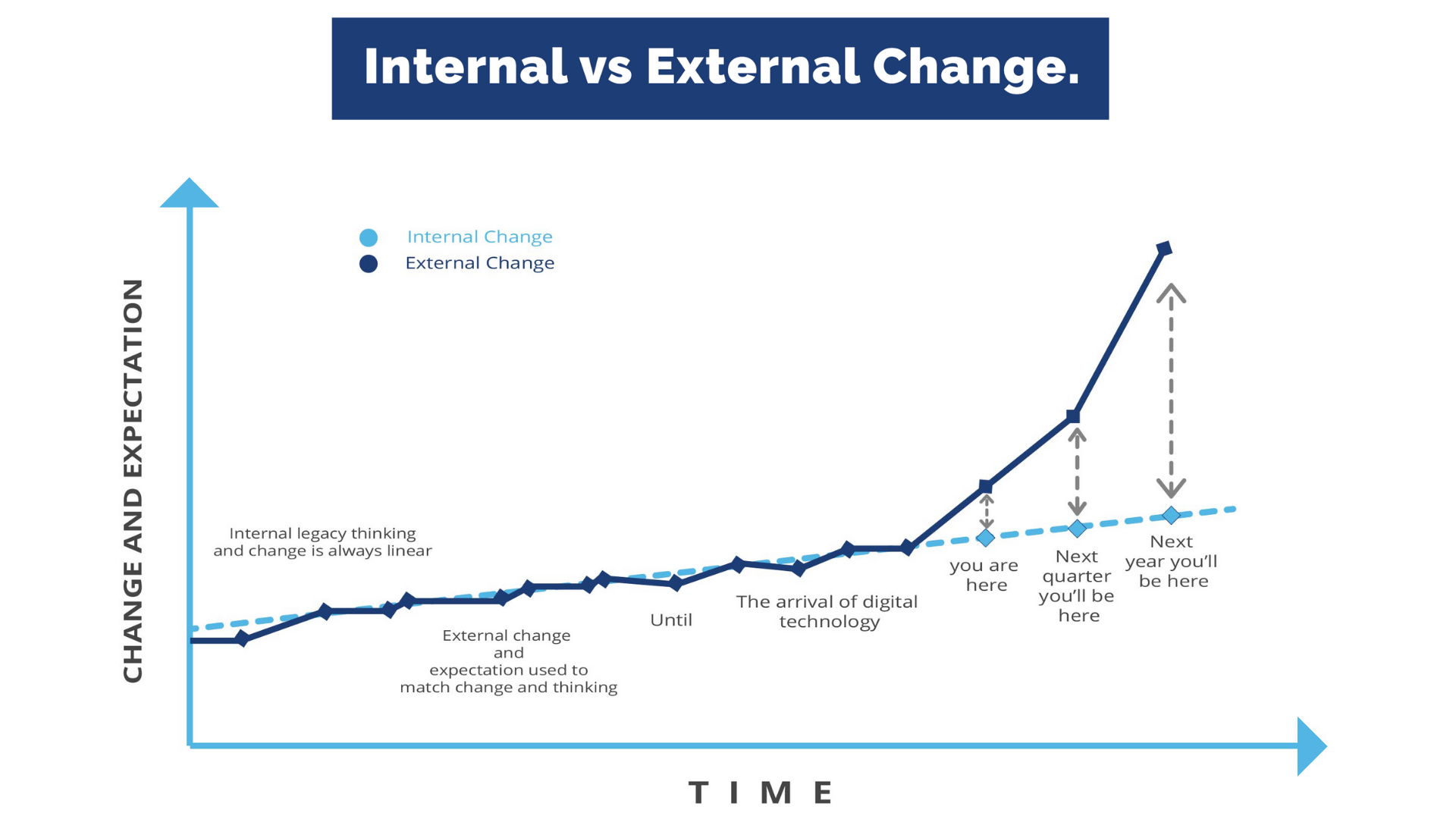
Download our guide—and also gain access to our receive our free Digital Readiness Assessment quiz where you will be able to quickly uncover your digital transformation barriers. Simply fill out this form, or continue scrolling, to read about:
Where the main barriers to digital transformation are
How you can identify your organisation's barriers
What you need to do to overcome your digital transformation barriers
As a busy CIO, CEO or technology leader, it sometimes seems impossible to think strategically about transformation when you’re already struggling with existing platforms, business requests and sometimes creaking legacy technology.
Digital Transformation isn’t a choice and we’ve been working with business and technology leaders for several years, helping them to understand the process and objectives of digital transformation, and how to get that journey on the right track.
So to help you do the same, this guide covers the most common barriers to digital transformation and how you can overcome them.
These common barriers are formed of five critical areas of Digital Transformation. I’ve uncovered these barriers and learned how to help businesses to overcome them over the years I’ve spent in leadership and consultancy roles. It’s highly likely that you’re experiencing some, if not all the issues I cover in this guide.
The five critical areas of Digital Transformation are:
If you are a CIO or a CEO with digital responsibility, or if you have a digital leadership role, then the information below will almost certainly be of use to you.
Digital Transformation fails for many reasons. By understanding the key areas and how to address the common issues you will be better prepared to overcome common causes of failure, and to remove barriers to transformation in your company.
Have you heard the old adage about two men in the mountains who see a bear?
One of them quickly bends down and starts making sure his shoelaces are tightly fastened. “What are you doing?” says the other man “you can’t outrun a bear!”. The first man looks up “I know, I don’t have to outrun the bear” he says, “I just need to outrun you”.
It’s a great metaphor, but the bad news is that the bear in this tale is the new digital age and every company, big and small must understand that the bear is coming for them whether they know it or not.
In order for a company to even survive, let alone thrive in the digital age, it must embrace and encourage new ways of working, create a culture of innovation, and put the customer at the heart of everything it does.
Ultimately, in the new digital age of business, the traditional siloed, inward looking technology change is simply not enough.
There must be innovation, collaboration and empowerment at every level to deliver value for the customer.
Digital transformation is driven by strategy, not technology. Less digitally mature organisations tend to focus on individual pieces of technology rather than a holistic digital strategy and the outcomes that new, digital opportunities can deliver.

A true digital transformation strategy should include a shared vision for transformation, and the pathways or outcomes required to deliver the vision. This in itself is a completely new way of thinking and can be difficult to achieve for companies who are low down on the digital maturity curve. Coupled with this strategy, there must be a leadership group responsible for both starting, driving and maintaining the digital programmes and initiatives across the company.
This is especially important in digital transformation programmes because of the cross functional nature of the work being undertaken. You will need a motivated and digitally aware leadership group in order to remove barriers and free up staff from business as usual activities, especially in the early stages of transformation.
For hundreds of years, companies have created hierarchies and the older the company, the more layers of hierarchy there are. This was absolutely the right way to manage business before the digital age. This model ensures that a steady state is achieved and that standardised product and service offerings are maintained.
Change is structured and assessed and led only from the top of the hierarchy. While that was absolutely the right way to manage business before the digital age, this model is the exact opposite of what your company now needs to do and aligning your leadership to the new way of working will be extremely challenging.
The legacy model has been totally invalidated by the pace of digital change, the unevenness of customer needs and expectations and the ease of which personalisation can be achieved through digital technology, which means that standardised products and services fail to meet the requirements of today's digital customer.
This issue is exacerbated by the people at the top of the hierarchy being unaware of the need for change until well after issues have arisen at the customer level. Along with confusion and disagreement over the cause of issues and the required remedial activity and not knowing where to start. This often causes further, large-scale IT type programmes to be initiated. For executives to understand that digital transformation isn’t an IT-led initiative is critical.
Executives, especially of pre-internet companies find setting sail towards an unknown destination a very daunting prospect, and the natural inclination is to avoid weighing anchor for as long as possible.
This is why an organisation's strategy and leadership can become the No.1 digital transformation barrier.
The standard and very normal way for most companies to change is a very linear progression.
This linear progression of thought and change no longer aligns to the external change of the digital age.
The graph below, while just a representation, shows how external thinking and expectation has overtaken internal thinking and pace of change. Internal change and internal thinking.
The image clearly shows that If the company maintains it’s current ways of working, thinking and change then the ever steepening rate of external digital change and expectation continues to get further and further out of reach of the company.
This will invariably mean one thing, failure.

The good news is that most executives are starting to understand that digital transformation is imperative for the survival of the business, even if they don’t necessarily understand the process.
Executives, especially of pre-internet companies find setting sail towards an unknown destination a very daunting prospect, and the natural inclination is to avoid weighing anchor for as long as possible.

To get your digital transformation underway, you need a vision which is shared across the entire company and a strategy which identifies the pathways to digital, or “digital destinations” which help to deliver the vision.
These digital destinations are usually a combination of digital products and digital outcomes. It’s important however to take this one step at a time and always remember that people don’t buy what you do, they buy why you do it.
So, aligning the most senior and influential leaders in your company before going out to the wider stakeholder community is vital for success.
A key issue often cited by executives is that because there is a lack of clear ROI data, digital transformation is perceived as a cost centre, and not an investment.
“When it comes to digital transformation and innovation, it seems many executives, boards, shareholders, and stakeholder are often “out of touch” with the factors driving market evolutions and disruptions. While they often perceive digital transformation as a resource that takes away from shareholder value and quarterly performance, the reality is that it is an investment in near and longer-term competitiveness and value creation. Without clear data that shows how digital transformation positively affects the bottom line, digital transformers or change agents struggle to get the resources they need to succeed.” – Alitimeter @Prophet
This issue combines many of the other barriers that we discuss in this eBook. Leadership being too inward facing, too far away from the voice of the customer, no innovation mindset within the organisation, too hierarchical. The list goes on.
It is also related to the way in which transformation is delivered. When transformation is technology led, and not business led. This approach results in IT pushing technology through to the business and calling it “Digital Transformation”.
This approach means nothing changes, and it is just a cost centre. The IT department do not understand or know where the opportunities for transformation are within the business. Only the business themselves, the people operating the processes, dealing with customers, who know every intimate detail of a particular aspect of the business have this knowledge. Part of transformation is tapping into this knowledge. This is often where the real opportunity for change is.
Where the real financial and service benefits are. So, it is critical to change the way in which transformation is delivered, what the objectives are and the way it is tracked, managed and governed.
The shared vision should identify in short but meaningful statements, the changes needed to enable the company to continuously deliver value to customers, as well as improving continuous internal change and fostering a mindset of innovation.
Select members of your company's leadership to be involved and collaborate to create the vision for transformation, and as quickly as possibly write an initial draft and continue to share and revise.
This document is a living document. It doesn’t need to be perfect and should not be delayed. This is the time for action, not perfection, and it should be approached in the same way as any other digital project. It should clearly define the changes needed to close the gap between your company’s current service offerings and your customers’ expectations.

If your leadership team still doesn’t recognise the importance of transformation, then it's likely you'll have an uphill battle on your hands and that could be seriously detrimental to any progress you intend to make. You're going to need to engage them with something that matters to them.
Here's how you can tackle the situation:

Coupled with the Shared Vision, there must be a leadership group responsible for both starting, driving and maintaining the digital programmes and initiatives across the company and a management function to coordinate the activities across the organisation necessary to achieve the objectives of the digital programme.
Successful coordination of these activities results in a sustainable digital delivery culture. This function can be called a Digital Portfolio Office.
The Digital Portfolio Office is especially important in digital transformation programmes because of the cross-functional nature of the work being undertaken. You will need a motivated and digitally aware leadership group in order to remove barriers and free up staff from business as usual activities, especially in the early stages of transformation.
The Digital Portfolio Office can also implement a framework of governance and benefits tracking across every digital initiative that is proposed by the business in order to assess the likelihood of success, the financial or service benefits and where necessary can prioritise which initiatives should be given more resource and budget. This framework also serves as a detailed reporting mechanism for executives who can now have real time data around financial benefits and ROI against the digital investments.
So following the advice in this guide, you’ll have a clearly defined ‘Shared Vision’ with leaders who are bought into transformation, a strategy to get where you need to be and a digital portfolio office to ensure the successful delivery of your digital initiatives across the organisation.
Do you want to know if your organisation is ready for digital transformation?
If you want to find out, take our short questionnaire and get your Digital Readiness Grade along with a free 22-page report packed full of insights and recommendations based on your answers.
What are you waiting for?
The term ‘digital transformation’ can be interchanged with ‘customer led transformation’ and is really about one thing; bringing your company back in line with customer expectations and enabling your company to remain in line, whatever external changes happen.
Therefore, always providing a great customer experience is central to any successful digital transformation.

As the term suggests, it’s not business that’s driving this change, it’s your customers.
If you're undertaking digital transformation, and if you’re not, you should be, then your customer experience (CX) should be your number #1 focus.
The value customers look for changes very quickly in the digital age, and it’s likely that competitors and new digital disruptors in any given sector will have uncovered these new opportunities already. Your digital transformation must ensure that continual change and innovation are at your company’s core.
It’s important to remember that in the digital age, the age of the customer that their consumption of digital services and products is changing how they find and evaluate and ultimately buy from companies. They are as much sales people for your company as your actual sales force are.
The experiences that customers look for change rapidly in the digital age.
It’s likely that your competitors and the new digital entrants in the markets your business operates in have already discovered and deployed digital products and services that capitalise on these opportunities.

Your digital transformation must ensure that continual change and innovation are at your company’s core if you want to compete in this situation.
It’s important to remember that now, in the digital age, consumers’ consumption of digital services and products is changing how they find, evaluate and ultimately buy from companies.
This new model ultimately means that your customers become just as much of a sales force for your company as your existing sales team. This is done following a great experience with your business through social endorsements, recommendations and the sharing of your key messages online, to other target consumers.
In the digital age, relying on static value propositions is inevitably a strategy that will fail.
The world outside of your company is simply moving too quickly in all kinds of unpredictable directions to rely on this. Digital transformation must address this issue.
When we talk about customer experience, what we are referring to is every single interaction that a customer has or has ever had with your organisation. Every one of those interactions must be a great experience, even if it’s a complaint or an otherwise negative process. If your company can’t deliver this, then it’s very likely that over the next 12-months you will start to lose customers and revenue to the competitors that can.
Remember that this is the age of the customer. They are firmly in the driving seat and will ultimately vote with their feet (or fingers!) if any aspect of their experience with your business doesn’t match their expectations. There are plenty of other options!
So how can you use digital transformation to deliver a world-class customer experience?
Let’s get one thing clear.
The answers are not inside your company, they’re outside.
You must look outside of your business to understand the customer needs and expectations and the gaps that exist between them and your services. It is also critical that you understand the competitive and technology landscape which will enable you to transform to successfully deliver against them.
Therefore, a key part of digital transformation is becoming an ‘outwardly orientated’ organisation.

Imagine when your company was first formed. Every interaction was perfectly defined to meet customers’ expectations and needs at that point in time. However, since then, significant gaps have will have formed, and digital technology has created a more complex customer journey. This is true for both B2B and B2C organisations.
Three very important questions to ask yourself right away are:
It's more than likely that if you answered those questions honestly your answers were...
If your answers were all "Yes!" then you're one of the few people in the world that's really nailing this. Well done!
If your answers were "No." then read on.
It is essential to clearly define the gaps that have formed between your services and the actual, real-time needs of the customer and it’s also essential that you understand that this is an ongoing, circular process that must be a constant in your company.
Remember that putting your customer first, should be an absolute priority.
No organisation exists to serve any other purpose but to deliver the services that it’s customers need.
This mantra is central to digital transformation and it’s one that a lot of companies and organisations have lost sight of. In fact, the larger the company and the longer it has existed, often means the further away from this principle they have become, despite the marketing messages they may disseminate.
Understanding the impact that digital technology and services have had on your customers is key to enabling you to identify ways you need to transform to meet those new and evolved expectations.
Companies like Amazon, Google and Uber have impacted the way that most of us expect to consume services. They’re offerings are instant, real-time, ubiquitous and often they even predict our needs, making these brands and their services part of our very thought process.
How to do it?
Like most things that are worthwhile doing, there’s no silver bullet or easy method to deploy.
Most of the analysis you need to produce can’t be automated, and quite simply you’ll need to get out of your comfort zone and start engaging, sometimes hearing uncomfortable truths that you may not want to.
The only sure-fire way to gain customer insight is to……. you guessed it; talk to your customers!

There are multiple ways to undertake this, and I’ll go into them in a bit more detail later, but essentially you, and especially your company’s leadership need to talk to customers in your target market and at multiple stages of the customer journey.
You must try to form a meaningful connection and really immerse yourself in the experience that they receive from you and learn what they value both inside and outside of your sector. Indeed, what they value from life in general.
The key objectives of this analysis and customer engagement are:
This information should form a major part of your digital vision. All that’s left to do is deliver the digital services that you now know you need to!
Some good ways of achieving the type of engagement needed to make the required connections are things like interviewing customers at multiple stages of the customer journey, and hosting events for customers to attend and give honest feedback in an open forum. You could incentivise them for this with free service or product. Develop a question script for customer services staff to run through on customer contact calls, even experience the service for yourself by mystery shopping your own organisation and your competitors. You can also use your social media channels to ask questions.
My simplified advice here is that the data gathered must be genuine, non-biased and completely honest feedback with no assumptions.
“Assumption” is the enemy of “fact”, and must be avoided at all costs!
Once the feedback is rolling in, then it’s time to start iteratively delivering the products and services you need to.

Some good ways to achieve a better customer experience and important elements to keep in mind are as follows:
Solving points of pain for your customers is the simplest and most effective way to gain traction and realise results in your digital transformation. Not least of all because there is a measurable before and after state to tangibly demonstrate positive results.
Try finding pain points that are both simple to measure and valuable to your customer. Look for low hanging fruit which has the most value and link that to a KPI or metric.
Enabling your customers to meet a long-term goal is more difficult than solving a pain point, but it’s extremely valuable for fostering loyalty and extending the lifecycle of your customer.
The key approach here is to choose multiple pathways and measure them at the same time to help choose what to scale and what to put further down the list.
Look outside of your business to your competitors and engage with your customers directly to understand their long-term needs, which are currently outside of your current value proposition.
Avoid falling into the usual traps by simply digitising existing process. This is a common mistake.
Digitising existing processes IS NOT digital transformation.
Digital transformation is not about creating more efficient processes or replacing people with automation. This is what inward facing companies do and is a legacy approach that has been proven not to work.
Ensure there is an ongoing way for senior leadership to engage directly with your customers through meaningful channels. Not online or automated surveys, but an actual conversation. This is fundamental to ascertaining what is important to your customers, and what will keep them coming back, and advocating for your business.
Remember, your customers are now your sales force.
Delivery and execution is the second critical goal of digital transformation.
To put continual change and innovation at the very core of your company is no easy task. The way we innovate and deliver products to the market has changed entirely and this change must be reflected in your company.
Digital technologies and new business methodologies enable a completely different approach to innovation. One that embraces risk, empowers people to fail and rapidly deliver products and services based on real customer feedback.
It is an extremely difficult task to move from predominantly waterfall based, technology driven IT projects to an agile, empowered, cross functional approach to change. But only when this happens will your company and its customers see real innovation, and new value in your products and services. And only then will you be a transformed organisation, ready to thrive in the digital age.

You must look to implement new methodologies based around Agile and Lean which promote rapid, iterative development. This enables the business to reduce the cost of testing and allows the project team to make their own decisions based on short development cycles and genuine user feedback. They must be empowered to take risks and fail fast. It’s a long way from the legacy project approach but this is the only way to develop a mindset of innovation within the business.
IT should no longer be driving digital projects, every project should be a business led initiative and highly cross functional. Remember that this type of approach should be about learning. Because the final destination isn’t and can’t be known, this approach is a learning based model. It’s very much a start-up mind set.
Investigate utilising Design Thinking cycles within each iteration. This is a great way to creatively solve problems and promote empowerment within the project team and engagement with the business.
The key here is to start small, but commit to iterative project delivery with a genuinely empowered cross functional team who embrace risk, and where necessary failure.

An empowered team should be able to make decisions without the need to go back to leadership. They should be dynamically adjusting deliverables and project scope based on feedback from users and customers. They should be experimenting with new ideas daily. Most of which will fail either technically or through user feedback.
This is how your company can learn what works, what doesn’t, and what your customers expect, which is exactly where you should be operating in the age of the customer.
In the same way that organisations use a Project Management Office to track, manage and ensure the success of IT projects, a Digital Portfolio Office is a framework of tools, processes and personnel with which to manage all digital initiatives within the organisation.
The Digital Portfolio Office has authority and mandate across all people, processes and platforms where the project falls under the digital transformation umbrella.
In today’s rapidly moving digital age, the technology and competitive landscape around your organisation is shifting constantly. Your organisation must learn to swim with the tide or risk being drowned by it.

As discussed earlier in this document, business that are thriving in the digital age are outward facing companies. Reacting rapidly to external forces, constantly changing, evolving and improving. It is critical to your company’s survival that you become an outward facing business and are completely aware of new technology advancements and how these could transform and enhance your company’s value proposition.
The second aspect of being outward facing is to remain aware of exactly what solutions your competitors and new digital entrants to the sector are offering which may meet your customers' expectations better than your own.
Digital disruptors have a major advantage over established businesses in that they don’t have to change. In the same way that when your company was founded, it was designed and set up to perfectly meet customer expectations.
This is the same position that new, recently founded companies are in. The only option available to established businesses is to be as open to external conditions as possible.

It’s no secret that the businesses thriving in the digital age are mostly outward-facing companies. Look outside of your organisation for new technology, new solutions and new ideas, and try to get into a ‘Founders’ mindset. Founders set up organizations to align perfectly with their clients’ needs, using the best technology solutions they can get. You also need to know about the solutions offered by your competitors and new digital players in your industry, which might be able to satisfy your customers' needs better than your solutions do.
Digital disruptors have a big advantage over established companies, because they don’t need to make any huge changes. When your company was founded, it was designed and set up to meet the customers' demands perfectly. In the same way, new, recently established companies are now in the same position. For established businesses, on the other hand, the only option they have is to be as open to external conditions as they possibly can.
We're in the age of the consumer and the experience economy. Everyone (and everything) is connected, consumers’ expectations have changed, and customers now want a personal relationship that can happen whenever—and wherever—they are ready to engage with you.
With all the choices open to customers now, it’s not surprising they expect more from their interactions with companies than in the past, and if you truly want to be part of the digital disruption revolution, you need to give it to them. Putting in place a sound digital customer engagement strategy that is customer-centric, committed, collaborative and creative enables you to give your clients the kind of experience they expect and also build relationships that work across any devices or channels.
Technology is changing every aspect of the business supply chain, from manufacturers’ inventory systems to workload management software for contractors. Digital tools are improving communications between various supply chain players, and predictive analytics makes it possible for us to use data to discover and match the demand of customers.
CIOs who wait to see what options their suppliers present to them risk being in the position that they have to accept digital methods that don't work for them. It's far better to take ownership of the digital disruption yourself, and become a driver of the kind of change that works for your business.
Now, there are new ways to keep up with your competition. Use digital disruption to your advantage by using machine learning and artificial intelligence to improve tasks like your competitor research.

Companies have done this type of research since the beginning of business to find the answers to questions such as:
Get real-time information through technology and build up a database of what your competitors are offering in your industry. You can also find out how their products and services compare with yours, and keep up with (or even overtake) their new activities.
Putting your customers first is an important part of digital transformation. This goes hand-in-hand with the founder way of thinking, but it doesn’t end with setting up the company.
There are multiple technological options you can choose for your customer relationship management (CRM), for example. There are also digital marketing functions that work very well, such as the generation and nurturing of leads, and you can even upsell and cross-sell based on messages sent to customers that are triggered by specific events in their lives.
By becoming a digital disruptor, you’ll be able to show how creative you can be for your clients, which they need to make them feel appreciated and valued.

Implementing a successful “digital-first” business model will do wonders for your company, but making it happen requires the right transformational leadership as well as strong innovations in technology. Don’t expect elderly managers to be able to transform themselves overnight into digital natives. Instead, look for people who are already comfortable with the technology you’re introducing, who understand how it can help them do more in less time, and who aren’t stuck on “the way we have always done things”.
Effective digital transformation depends on changing the company’s culture at grass roots level, because it relies on every employee being willing and able to adopt completely new ways of working. To make this happen, you’re likely to come up against resistance to change among your staff. You will also have to overcome accountability issues, fear, and the use of false logic.

Digital disruption is no longer a vague idea put forward by analysts and vendors, though. We were able to see evidence of this in a recent survey from Forbes Insights, which showed more than a third of executives are finding themselves directly affected by competition from more digitally-focused companies in their industries.
An organisation’s culture is universally recognised as the biggest barrier to digital transformation in every sector and size of business.
This is true in the private sector, public sector and not for profit sector.
I often speak with CEOs, CIOs, CTOs, and Delivery Leads that have become jaded and frustrated with digital transformation and business change management projects and programmes because their people and business culture fights against what they are trying to achieve.
They’re literally pulling their hair out (or what’s left of it).
However, when your company culture aligns with your vision for transformation, then you have a very powerful and highly valuable asset. This creates a competitive advantage and underpins the success of your transformation programme.

As tough as it is to admit, your company’s culture is one of the main reasons that you need to undertake digital transformation in the first place.
Transformation isn’t about technology, but it’s success relies on every single member of your organisation being able to adopt completely new ways of working.
So, it should come as no surprise that the number one cause of failure for digital transformation programmes is organisational culture.
This guide will help you to understand your end goal – creating a digital culture. Then we’ll look at the cultural barriers, their impacts, and how to overcome them.
The kind of culture that is critical for digital transformation to succeed is one that embraces change and where its people are empowered to fail. Where innovation is rewarded and where taking risks is encouraged in a highly collaborative environment. Encouraged because failure breeds learning and learning breeds innovation which in turn breeds success.
A digital culture has primarily an outwards focused orientation, rather than inwards. Employees and leaders are encouraged to look to partners and engage with customers to create new solutions and products.
Taking risks is encouraged. People are empowered to fail fast and learn. Most things fail. That’s life. In order to move forward, there must be some failures. This is acceptable.
In a digital culture, the status quo isn’t acceptable. A digital company knows that if it sits still, then it’s falling behind. This isn't just a leadership thing, its top to bottom and left to right. You don’t have to be a CEO to spark change in a digital organisation. Most digital transformation starts with small pockets of innovation which deliver results and wins support and willingness to make bigger and bolder changes.

In a digital culture, people are empowered to make decisions without the need for a committee or sign off. There must, of course, be some guiding principles and boundaries, but your people must be trusted to make decisions. This creates a much flatter and less hierarchical organisational structure.
Digital organisations stop planning, at least in the traditional waterfall sense of the word. A digital company only plans short term. In the digital age, things move way too fast for any traditional planning to be meaningful. By the time the plans are drawn up, they’re out of date and you’re still falling behind. A digital culture promotes speed and iterative development. New products are launched as soon as possible, not when they’re perfect. New conclusions, new ideas and improvements come from real user feedback after a few weeks, not months or years.
In a digital culture, there are no individuals.
We have to promote collaboration at all levels and not an individual effort. Cross-functional working is the norm.
There are no more IT projects.
Every project is a business project.

Most companies today operate in exactly the opposite way than I’ve just described. Most companies feel they have to fit into the norm of careful planning, not making mistakes and risk management. Staff who fit into the hierarchies and who make the fewest mistakes are the ones who seem to do the best. Staff who take the fewest risks and work only within the silo of their own department or business unit are the ones who get the promotions.
So considering all that, it’s no wonder that digital transformation fails if you don’t specifically do targeted work around your culture. This kind of shift in the way you need people to behave and think cannot just happen by itself, organically because you decided to “become digital”.
However, even with focussed work and proactive leadership, your people will resist this change. 90% of them will sweat when faced with a change to a process or system, let alone a complete change in the way they need to think.
This isn’t a choice they make. It’s hardcoded, rooted deep within our DNA.
Humans love convenience. Almost every piece of technology that ever existed is to promote convenience or eliminate effort. But we instinctively avoid new process or change because it brings risk and uncertainty. It also brings effort. The very thing we are all trying to avoid with technology and innovation in the first place.
The issue isn’t the adoption of something new, it’s the process of change itself. Even people who enjoy learning and technology avoid the effort of making a change, especially in the workplace. As soon as we've finally made the change, we start to avoid changing it again.This cycle doesn’t end unless we make it end with hard work and effort.
We go through our own personal transformation all the time.
Think about the last time you got a new phone. The stages are exactly the same. The process is well documented and is written about in countless change and management publications, blogs and papers.
The process goes something like this:
“I don’t need a new phone”
“They’re really expensive”
“They’re much harder to use”
“I only use my phone for x, y and z anyway”
“There are too many choices”
“What about all of my data and pictures of little Billy?”
“What if I don’t like it?”
“What if it’s too big/small?”
“What the heck does that noise mean?”
“What is this new button layout?”
“How can I find my calendar app?”
“I knew I shouldn’t have done this. I hate it!!”
“This is the BEST phone I have ever had!!!”
“Why didn’t I do this sooner?”
“I can take better pictures”
“I can message faster
“I’ll never miss another appointment”
“I can just tell it what to do!!”
“I was looking at my old phone the other day it is so big and heavy”
“The apps run so slowly compared to my new one”
“Why did I wait so long???!!!”
Then the process starts all over again. This is the way things are. We cannot change our DNA, but we can be aware of it and manage the natural instincts by ensuring that our culture enables and promotes the right way of working.
Real digital transformation is about being more adaptive to change and accepting it as the default state.
There are generally 3 ways in which your people are going to become hurdles to your transformation and if we can understand how that happens, we can address it head-on and ensure that transformation doesn’t fail.

Key Reason number #1 and the biggest most frequent barrier to transformation.
Your people do not have an innovation mindset.
This is the most common reason that companies fall behind the technology curve. The kind of mindset needed for transformation is one that embraces change, rewards innovation, takes risks, learns quickly from mistakes and is highly collaborative.

So how can you promote the innovation mindset?
How can you get your people to operate and think in an entirely new way?
Firstly, you need to help people see the benefits of change. This can only come from showing them and letting them see for themselves the positive outcomes from digital initiatives which have already been delivered.
The way we leverage the positive results of change and disseminate this around the organisation is critical to spreading and promoting the innovation mindset.
You should look to introduce incentives for being more innovative. This will start to get people thinking and working with a more innovative mindset.
You can start by incentivising the measures covered in the next section that relate to changing what your people do.

Firstly, changing what people actually do is critical to instilling the innovation mindset. It’s pointless to expect different outcomes if what they are doing and the way they approach their day to day lives in the company stay the same.
Some ideas around activity measures or input measures are as follows:
All of the above will serve to change the way that people prioritise daily life within the business, and keep innovation at the forefront of their minds.

Some ideas around measuring output are as follows:
The next type of measure are the outcomes or outputs that come from working innovatively. These measures need to make it clear that it is everyone’s responsibility to be involved with digital initiatives:
Some ideas around hard measures are as follows:
Thirdly and the most important are the hard measures. The actual business outcomes that your people achieve through working more innovatively.
Construct environments and provide access to tools that promote:

The second way that people become barriers is that they operate with false logic.
Here’s the logic:
“this is the way we’ve always done it so there must be a good reason for it”
And this assertion causes resistance.
The simple way to deal with this is to trace the logic back to its root cause and publish the findings.
If you can show people that their logic is false, then the resistance should dissipate.

The final way the people become barriers to transformation is because of poor accountability.
What we’re talking about here is the accountability between the actions of staff and the success of the company. This is critical for a digitally mature organisation.

For any organisation to be efficient at serving its core purpose, all effort and work needs to be measured against whether or not it contributes to that purpose, and this is especially true for organisations that need to digitally transform.
Otherwise, people will simply carry on doing the same today as they did yesterday. Implementation of new platforms are essentially pointless investments. Again, we’ve already mentioned this theme. This is a trait of inward facing organisations. We’re not looking outwards, putting ourselves in the shoes of the customer or looking beyond our own area of responsibility.
Poor accountability also removes any sense of urgency or time-based pressure. This is especially prevalent in Public Sector organisations that have a captive market. This, in turn is exacerbated by inwardly focused management that create their own methods of performance management that do not contribute towards the company’s mission.
Support functions such as IT and HR need to be just as accountable for the productivity they enable.
When HR performance is measured on cost saving and time efficiency this kills innovation.
IT KPI’s around simply keeping things working means no there is no incentive to find innovative ways to facilitate better organisational wide performance, or enabling better connectivity and collaboration between systems and external partners.
Often, upgrades are missed or discounted because of the short term cost implications. When in reality there is an widening gap between the capability of existing systems and what the external needs and what the customer already expects.
All of these things destroy innovation.
It is critical to develop accountability that links directly to the transformation vision and the organisation's mission or positioning statement.

To recap, there are three ways that people become barriers:
1. They are missing the innovation mindset.
2. They are operating with false logic.
3. They have poor accountability.
To overcome these and many other cultural issues isn’t easy.
In fact, it’s the most difficult part of any digital transformation. Digital change brings uncertainty, hard work and a new way of operating on a daily basis for the entire company.
The real focus of digital transformation is about delivering new ways of working that ensure a process of continuous, iterative change is at your company’s core.
Education and engagement are key to your company’s cultural transformation.

Resistance to change is a completely natural and even hard-wired human reaction. However, it’s almost certain that there will be some difficult decisions to make as your transformation gets underway.
If your staff can’t or won’t get on board then there really is only one option.
Your entire company must be on board, with no exceptions.
Ground zero.
Your need to develop a digital culture assessment framework (this can be a spreadsheet, no need for fancy software), and assess every team, role and leader against the following three attributes:
Ask…
We need the answer to be “yes” for all of these people.
Ask…
We need everyone to be able to take ownership and self-learn.
Ask…
Again, we need this to be “yes” for everyone.
For many of you reading this guide that undertake this kind of cultural assessment, you’ll discover that you have lots of people resistant to change, pessimistic about the need for change, hating new technologies and processes, shirking responsibilities, not teaching themselves anything, ignoring changes until they’re falling off a cliff, and most of all, not creating any measurable impact on the business’s overall success.
This means that your digital transformation programme will fail unless you empower all of your people with a shared vision and provide support and education that empowers them to engage with the process, and tell them regularly exactly how they are contributing to the organisation's success.

Once you have a clear picture of the culture within your organisation you can target the problem areas. Not only that, you can find the pockets of digitally mature parts and people in your company and use them to assist in spreading that digital culture across the organisation.
Building a digital culture takes time, and effort. So, start this initiative as soon as possible.

Once you have a clear picture of the culture within your organisation you can target the problem areas. Not only that, you can find the pockets of digitally mature parts and people in your company and use them to assist spreading that digital culture across the organisation.
Building a digital culture takes time, and effort.
So start this initiative as soon as possible.
If you're not sure where to start, or if you'd like to find out if there's something you might have missed, then take our free online Digital Readiness Assessment.
Here's what you need to do:
Hello, I'm Chris and I lead the team at Cavendish Wood. We specialise in helping ambitious CIOs, CTOs and CEOs to transform their businesses to meet their constantly evolving customers’ behaviours, expectations, preferences, and needs through successful digital transformation programmes.
I'm immensely passionate about changing the fortunes of businesses – helping them to go beyond survival and thrive in the digital age. If you feel the same or are interested to learn more about Cavendish Wood, let's connect!
Twitter: @chrisfutcher
LinkedIn: /chrisfutcher
Email: chris.futcher@cavendishwood.com
Phone: +44 7971 826661
Digital Transformation is on the agenda in nearly every boardroom of every company in the world. If you’re the CXO or change lead responsible for the delivery of transformation and digital change at your company, you may feel you have a mountain to climb.
That’s often because the real challenge of Digital Transformation is about putting new ways of working in place that ensures a process of continual change and customer-driven service improvement, is at your company’s core.
Often, companies simply aren’t ready to dive straight into transformation, and without understanding the barriers to transformation that exist in your company, any efforts will almost certainly fail.
This Digital Readiness Assessment tool will focus on the five key areas of your business which are critically associated with the success or failure of digital transformation:
- Strategy & Leadership
- Customer Experience
- Delivery & Execution
- Technology & Competitive Landscape
- People & Culture
Get your overall grade now (A, B, C, or D) and then an analysis with recommendations for each of these five areas in your free 22-page report.